It’s time to try something new! I was recently challenged to show something in database page with a hex editor for another blog post. I thought, “Hex what? Are we casting spells?”
Let’s start with, “What is a hex editor?” It’s a program that lets you view the binary of a computer file – the 0’s and 1’s that it’s made of. There are many available.
I started with my coworker Kendra Little’s (blog | twitter) blog, Corrupting Databases for Dummies- Hex Editor Edition. I downloaded the hex editor XVI32, as recommended. She gives instructions on how to install the software, create a database, create some objects, and then open the hex editor to break a page.
Note: this should not be done in, near, or even in the same state as a production database.
Beyond the basics of her blog post, here are the steps I went through to view a database page, break it, and fix it.
Breaking the Page
I issue DBCC IND to view a list of pages that belong to a table or index. The syntax for the command is:
DBCC IND ('DBName', 'TableName', <indexnumber>);
I run the command:
DBCC IND ('CorruptMe', 'DeadBirdies', 2);
Make note of a file and page number to work with. I issue a DBCC PAGE command to view page 1116. The syntax for the command is:
DBCC PAGE( {'dbname' | dbid}, filenum, pagenum [, printopt={0|1|2|3} ]);
I run the command:
DBCC PAGE('CorruptMe', 1, 1116, 3);
Following the steps in Kendra’s blog, I take the database offline, copy the physical file location, and figure out my page offset. I’ll need that information going forward.
The Hex Editor
Next, I open XVI32 and open the file. Well, that’s kind of fun-looking!
Quite frankly, I have no idea what the heck I’m looking at.
To find the page I had selected, I go to Address > Go To and enter my offset value. I’m now seeing the page on the right side. I can tell this because I can see the word “Tweetie” – the data I inserted in the table.
I click on the first T and type X. Apparently I’ve just changed the data in my data file. Oops! I’ve corrupted a data file!
I save the file and go back to SSMS. I bring the database online. That works without a problem. I run a query to view data in that table, which should access the nonclustered index I mangled.
USE CorruptMe;
GO
SELECT birdName
FROM dbo.DeadBirdies;
I get a terrible error: “SQL Server detected a logical consistency-based I/O error: incorrect checksum”.
What happens if I run a DBCC CHECKDB? More errors!
Yes, I broke a database. On purpose.
But this is good! It gives me the opportunity to play with a hex editor, see what corruption errors look like, and fix them.
Fix them, you say? Yes, fix them!
Fixing the Corrupted File
This is an easy fix. A corrupted nonclustered index can be fixed by dropping and rebuilding.
First, I go to SSMS and expand the database, table, and indexes. I right-click the index and select Script Index As > Drop and Script Index As > Create To > New Query Editor window.
I run the query to drop the index:
DROP INDEX dbo.DeadBirdies.ncBirds;
When I run the query again, data is returned! This time, there is no error.

Now, I rebuild the nonclustered index using the Create statement I scripted, and I can still run the query without errors.
CREATE NONCLUSTERED INDEX ncBirds ON dbo.DeadBirdies(BirdName);
What I Learned
Someday, I may need to manually edit a database (or other) file. This is one of those tasks it’s nice to know I’ve done in practice before I ever need to actually do it – I know what to look for and what to do. I won’t need to panic at a critical moment.
Magical! Where is @SQLUnicorn when I need him?





 Jes Borland is a Premier Field Engineer - SQL Server for Microsoft, where she is a trusted technical adviser, deep technical support, and teacher for her customers. Her experience as a DBA, consultant, and 5-time Data Platform MVP allow her to help the business and the IT teams reach their goals. She has worked with SQL Server as a developer, report writer, DBA, and consultant. Her favorite topics are administration, automation, and performance. She frequently presents at user groups, SQL Saturdays, and other community events. She is also an avid runner and chef.
Jes Borland is a Premier Field Engineer - SQL Server for Microsoft, where she is a trusted technical adviser, deep technical support, and teacher for her customers. Her experience as a DBA, consultant, and 5-time Data Platform MVP allow her to help the business and the IT teams reach their goals. She has worked with SQL Server as a developer, report writer, DBA, and consultant. Her favorite topics are administration, automation, and performance. She frequently presents at user groups, SQL Saturdays, and other community events. She is also an avid runner and chef.

